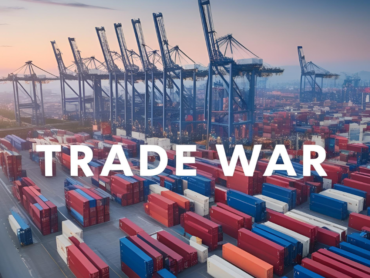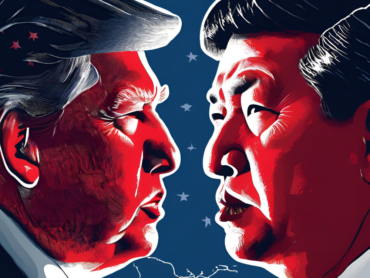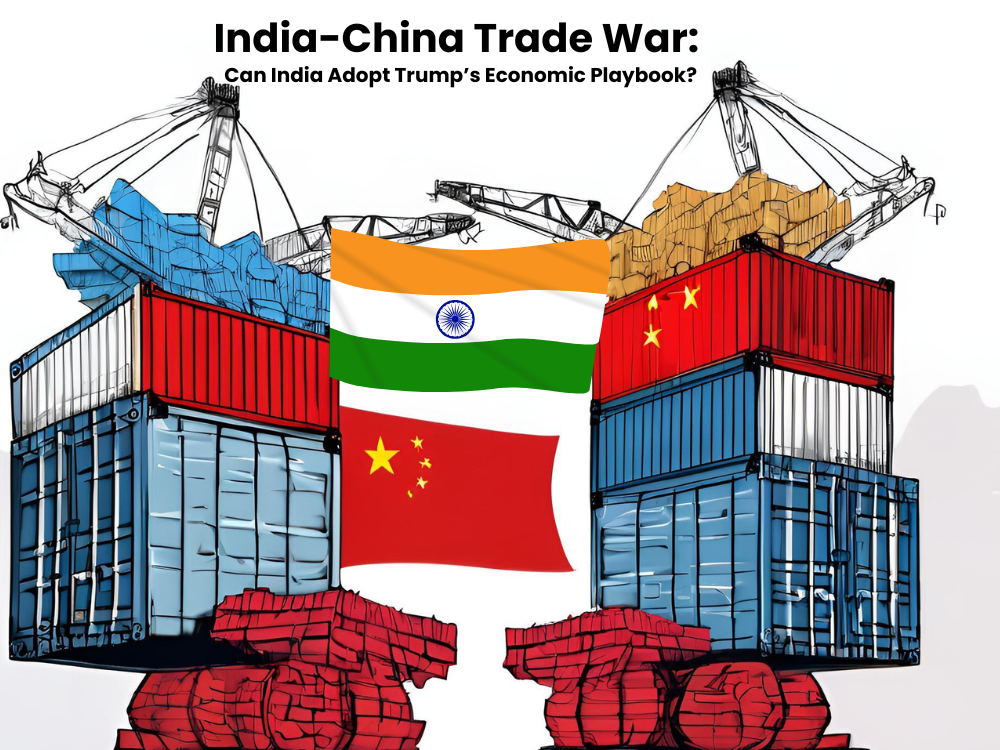1. Introduction
The India-China Trade War is no longer just a theoretical concern. In 2025, India’s trade deficit with China surged to a record $99.2 billion. The figure reflects a growing economic imbalance that challenges India’s aspirations of self-reliance and manufacturing growth. As this gap widens, policymakers and analysts are asking a bold question: Should India take a leaf from former U.S. President Donald Trump’s aggressive economic strategy and apply similar tactics to reduce its trade dependency on China?
Trump’s trade war with China was rooted in tariffs, confrontation, and a push for domestic production. While India has taken a more diplomatic and multilateral approach to global trade, the intensifying deficit suggests that a more assertive policy might be needed. However, the Indian context is markedly different from that of the United States. Any policy shift must account for India’s developmental goals, supply chain needs, and geopolitical considerations.
2. What Is the India-China Trade War?
The India-China trade war refers to the rising economic tension between the two Asian giants due to an imbalanced trade relationship. As of FY 2024–25:
- Imports from China: $113.45 billion
- Exports to China: $14.25 billion
- Trade Deficit: $99.2 billion
Several structural dependencies underpin this gap. India continues to rely heavily on China for essential imports such as electronic components, smartphones, solar panels, and pharmaceutical raw materials. Meanwhile, Indian exports—largely comprised of raw materials such as iron ore, cotton, and aluminum—have seen reduced demand in the Chinese market. These trends reflect not just trade imbalances, but also deeper issues related to industrial capacity and global value chain participation.

3. Understanding Trump’s Economic Playbook
The trade strategy employed by Donald Trump during his presidency was direct and confrontational. Trump targeted China with tariffs exceeding $360 billion in a bid to reduce the U.S. trade deficit and force Beijing to renegotiate trade terms. The key features of his policy included:
-
Imposition of high tariffs on a wide range of Chinese imports.
-
Direct negotiations with China that prioritized American manufacturing.
-
Accusations against China for intellectual property theft and unfair trade practices.
-
A broader agenda of re-shoring production to the United States.
The Trump administration believed that aggressive economic tactics could realign global trade in America’s favor. While these policies sparked a retaliatory trade war and disrupted global markets, they also demonstrated the impact that a hardline stance could have in renegotiating terms with a major trade partner.
Links Suggested: India-Sri Lanka Relations : 5 Strategic Wins for Both Nations
4. India-China Trade War in 2025: What’s Fueling the Gap?
India’s growing trade gap with China is driven by multiple interconnected factors.
First, India’s industrial sector remains dependent on low-cost intermediate goods from China. Products such as solar modules, semiconductor components, electric batteries, and machine tools are not yet manufactured at scale domestically. This dependence has been further deepened by initiatives such as the Production Linked Incentive (PLI) scheme, which inadvertently increase imports for production.
Second, India’s exports to China are mostly low-value raw materials. As China moves up the value chain and focuses on high-tech and domestic consumption, the demand for these goods is diminishing. Unlike Southeast Asian countries like Vietnam or Malaysia, India has struggled to integrate itself into higher segments of global supply chains.
Third, the price advantage that Chinese goods offer continues to attract Indian manufacturers and retailers. While Indian products may be competitive in quality, they often fall short on cost and scalability.
5. India-China Trade War: Can India Replicate Trump’s Approach?
In theory, India could adopt elements of Trump’s trade policy. However, the feasibility of such a move is debatable. The United States is a consumption-driven economy with greater leverage in global trade, whereas India is still emerging as a manufacturing hub. Additionally, the U.S. dollar’s status as the global reserve currency allows the United States to bear the brunt of retaliatory measures with more resilience than India can.
Nevertheless, some tools used by Trump could be adapted to suit Indian realities. India has already imposed anti-dumping duties on certain Chinese products. It has also increased scrutiny on Chinese investments and supply chains. But a full-fledged trade war carries risks that India might not be in a position to absorb at this stage of economic development.
Links Suggested: India-Bangladesh Relations: Why India Withdrew the Trans-Shipment Facility
6. India-China Trade War: What Would a “Trumpian” Approach Look Like for India?
If India were to implement a Trump-style strategy, it would involve several aggressive policy shifts.
- Tariffs: ariffs would be increased on a broad range of Chinese goods such as electronics, toys, and solar equipment. especially those that compete directly with Indian manufacturing sectors.
- Anti-Dumping Measures: anti-dumping probes would be expanded, particularly in sectors like chemicals, toys, steel, and electronics.
- Local Preference: India could also restrict access to government procurement for Chinese firms and mandate local sourcing for public sector projects.
- Import Monitoring: A new import monitoring mechanism is reportedly being considered to track low-cost Chinese goods and prevent rerouting via third countries.
- Capital Restrictions: Limiting Chinese investment in sensitive sectors.
However, such steps must be implemented with caution. Higher tariffs could lead to increased costs for Indian manufacturers and consumers. Moreover, any disruption to the availability of critical components could stall sectors like pharmaceuticals, electronics, and renewable energy.

7. Risks of Escalation
Engaging in a direct India-China trade war could lead to several risks:
- Inflation: Tariffs would raise the cost of essential goods such as mobile phones, medicines, and consumer electronics.
- Supply Chain Disruptions: Sudden restrictions could stall sectors like EVs and solar energy.
- Export Retaliation: China could target Indian pharmaceutical and agricultural exports.
- Diplomatic Fallout: Trade tensions could spill into strategic and geopolitical issues.
Moreover, India-China trade war would likely strain bilateral relations, impacting cooperation in other areas such as border security, multilateral forums, and regional stability. India’s role in initiatives like BRICS, the Shanghai Cooperation Organisation (SCO), and RCEP would be complicated by such a policy shift.
8. Alternative Strategies for India
Instead of resorting to a India-China trade war, India can explore a range of strategic alternatives.
- Diversification: Increase trade with countries like Vietnam, Indonesia, the EU, and the U.S. to reduce dependence on Chinese imports.
- Strengthening Domestic Manufacturing: Expand support for initiatives like Make in India and Atmanirbhar Bharat with targeted investment and policy support.
- Global Trade Engagement: Negotiate trade agreements that improve India’s market access and reduce tariff barriers for Indian exporters.
- Technology and R&D Investment: India must invest in innovation and domestic production capabilities in electronics, green energy, and defense.
Additionally, India must improve its participation in global value chains. This means creating policies that encourage integration into international supply networks, especially in electronics, automobiles, textiles, and pharmaceuticals.
9. Looking Ahead: A Strategic Roadmap
India’s response to its trade deficit with China must be multi-dimensional. A one-size-fits-all approach will not be effective. A successful strategy should include:
-
Targeted tariffs on non-essential imports where domestic alternatives exist.
-
Investment in critical sectors such as semiconductors, green energy, and defense manufacturing.
-
Bilateral agreements with countries that can provide alternatives to Chinese inputs.
-
Export incentives and market access agreements to boost outbound trade.
-
Incentives for R&D and high-tech innovation within Indian industries.
These steps will help India gradually decouple from Chinese supply chains without triggering a full-scale economic conflict. The goal should be resilience, not isolation.
10. Conclusion
The India-China trade war in 2025 is not a declared conflict, but the numbers speak for themselves. A $99.2 billion trade deficit is unsustainable and exposes India’s economic vulnerabilities. While the Trump administration’s hardline approach offers useful insights, India’s path must be tailored to its unique position.
Rather than copying Trump’s aggressive stance, India should craft a calibrated strategy—balancing assertiveness with pragmatism. The focus must remain on building domestic strength, diversifying trade partnerships, and ensuring that future trade relations with China are based on mutual respect and strategic balance.
India has the opportunity to shift from reactive policies to proactive transformation. Whether it chooses confrontation or cooperation, the objective must remain clear: building an economy that is competitive, resilient, and self-reliant.


[…] Links Suggested: India-China Trade War: Can India Adopt Trump’s Economic Playbook? […]